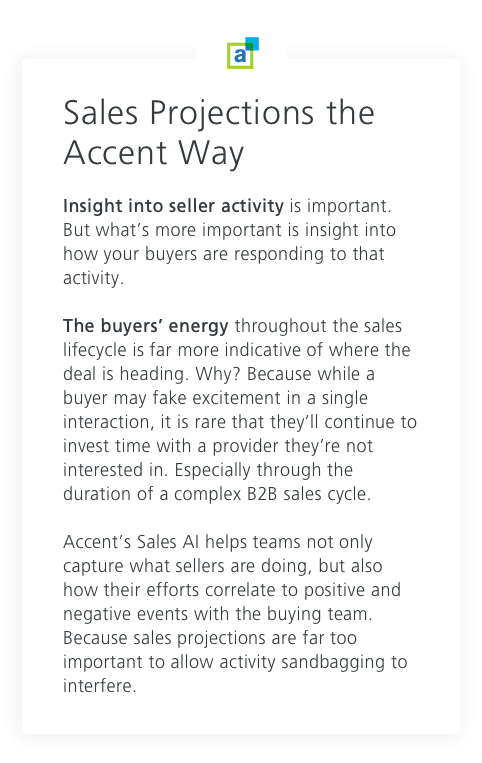uncategorised
Sales Projections
Have you ever wanted to get a glimpse into the future of your business and see what lies ahead? Then sales projections are about to become your new crystal ball.
Businesses that fly blind with no plans for what lies ahead or understanding what the immediate future might look like are at a disadvantage. Prepping for the quarter or year to come can help companies avoid over- and understaffing, can help them make sure they have the right product amounts on hand, can help them figure out where to spend their marketing dollars most effectively, and more.

Sales projections aren’t just sheets full of numbers – it’s a chance for you to plan for the future and head off potential problems before they come to fruition and affect your business.
And yet, despite all of the insight sales projections can offer, many businesses are afraid to utilize them. They might feel like they don’t have enough sales volume to bother or that sales projections are just barely educated guesses and not worth the time or effort.
None of this is accurate – and today we’ll demonstrate not only what sales projections are, but how they can help you grow and how you can start implementing them immediately.
What is a Sales Projection?
If you’re not familiar what sales projections are, let’s clarify that before we begin.
Here’s a common sales projection definition:
A sales projection is essentially a prediction of how many sales and how much revenue you’ll generate in a given timeframe. It uses data to determine what these numbers should be, but like all things that rely on looking into the future, it’s not set in stone.
While advances in computer learning, Artificial Intelligence, and technology have given us the ability to make more accurate projections, it’s important to remember that internal and external factors can push your predictions off course.
A great example of this is Covid-19. It seems highly unlikely that anyone predicted a global pandemic that would shut down huge chunks of the world when they were doing their 2020 projections last year.
It seems safe to say that the pandemic has played havoc with everyone’s projections this year, but events don’t have to be global or cataclysmic to throw off a forecast. Simple things like management changes, regulatory changes (ask the vape industry how this has affected their business over the course of the past few years…) or a multitude of other issues can alter your projections significantly.
So, remember – sales projections have a lot of value, but they’re still just projections. Sometimes things beyond your control will knock them off course.
Is a Sales Forecast the same as a Sales Projection?
If you’ve been around sales for any length of time, you’ve undoubtedly heard about sales forecasts and sales projections. The two terms are often used interchangeably, but are they the same thing?
For the purposes of this article? Yes.
There are semantic differences between sales forecasting and revenue forecasting, as well as sales projections and sales plans, but sales forecasts and sales projections are essentially the same thing.
SEE ALSO: What is Sales Forecasting?
SEE ALSO: Sales Forecasting Examples
Why do I need a Sales Projection?
Hopefully, by this point of the article, the question of “why do I need a sales projection” is largely rhetorical.
Earlier, we touched on how a quarterly or yearly sales forecast can provide insight into how you should plan to conduct your business moving forward.
Beyond that, sales projections can show you where opportunities lie that you might have otherwise missed. It can also show you potential problems in your sales pipeline, where your sales team can perform more effectively, and where your focus should be to maximize revenue.
Utilizing a sales management AI solution with both predictive and prescriptive analytics tools can help you see where your process can become more efficient and help you move the needle even further.
You might be thinking that creating sales projections is hard – but trust us: running a business without sales projections is even more difficult. If you can’t see the path ahead, you’re far more likely to walk right off the edge of the cliff.
How to Create Sales Projections
Creating a sales projection doesn’t have to be difficult. In fact, if you’re using the right kinds of software, the whole process can be completely painless as technology will crunch the numbers for you and provide you with a handy report.
If you’re not using sales management AI software (and if you’re not, why aren’t you?), you can still do projections the old-fashioned way. The results might not be as good as they are with software using your analytics to make predictions, but you can still get a solid projection.
The simplest way is to simply make projections based on previous sales data.
If you know you sell 10 of a $10 item per month on average, you can generally assume your new projection will account for $1,200 in revenue for that product for the next year.
Easy, right?
The problem with this kind of forecasting is that it operates under the assumption everything will remain the same. And as we all know, change is the only constant in life.
So, even if you project optimistically, hoping for a 5% increase, there’s no real way of knowing here other than just forecasting based on past performance.
This is commonly called a Historical Projection, and it’s one of the least reliable methods of sales forecasting…for obvious reasons.
If you have a good sales team with lots of years of experience, you may find Intuitive Projections are a better option than Historical Projections.
As the name implies, intuition plays a key role in intuitive projections. Your sales team will be a valuable source of insight here, as how they feel about recent history will play a key role in determining what you project for the future.
The challenge here, like historical projection, is that the predictions rely more on feelings and past performance than raw data. If you have a sales team that can be objective and insightful, then intuition projections might work out for you – but if you have a less experienced team, you might be better served with one of our other options.
Our next contender can offer tons of insights, but requires more efforts than the previous approaches.
Pipeline Projections take a wealth of data from your sales pipeline and build predictions around that data.
Things like the sales cycle length, sales velocity, close rates from various parts of the pipeline, and more form the foundation of this approach.
Sales management AI platforms with a robust analytics package can make this kind of projection extremely effective, but you can do it manually as well.
There’s work involved in this kind of forecasting, but the results justify the effort.
And finally, we come to the last approach: Multivariable Projections.
This one takes the sales pipeline approach and goes even farther, factoring in a wide range of variables both from your sales data and beyond.
Multivariable projections are complex and really benefit from the aid of analytics software because the predictions require so much data to paint an accurate picture.
That being said, this is one of the best ways to get a truly detailed sales projection.
SEE ALSO: How Sales AI Improves Pipeline Management
How Detailed Should my Projections Be?
After picking the sales projection approach that’s right for your company, the next question most people ask is how detailed these projections should be.
The simple answer? It depends.
Fortune 500 corporations might run hugely detailed sales projections, while a new restaurant owner won’t need anything nearly as detailed.
So, the first step is determining what specific sales metrics matter most to your business and building around them.
There’s a tendency to go overboard here – but in reality, most businesses don’t need to create detailed projections for every product or service they sell. In many instances, it’s easier to break things down into groups.
Going back to our restaurant example, the owner is usually better to create projections based on say breakfast, lunch, dinner, and beverages than each individual menu item.
Of course, if you’re using sales analytics software, you can have the best of all worlds without a lot of extra effort. Those programs can crunch all of your data and provide a wealth of reports that give you a bird’s eye view of your business or one that goes all the way down to the sub-atomic level.
No matter what you choose, the key here is to keep it manageable. Analysis paralysis is real and there’s no need to make this process more complicated than it has to be.
Sit down, figure out which 8-10 metrics matter most to you, and build from there.

What Factors Affect Sales Projections?
Finally, let’s take some time to talk about things that can affect your sales projections – both positively and negatively.
We’ve already talked about things like Covid-19 and some other internal and external factors, but here’s an even bigger list of things to consider.
Sales Drivers
There are many different factors that can affect how much (or how little) you sell in any given timeframe. We call these sales drivers and oftentimes they’re at least somewhat out of our direct control.
That doesn’t mean we shouldn’t be aware of them, though. Things like seasonal sales ebbs and flows, changes in your market, and so on can affect your projections dramatically. Because of this, it’s smart to plan for them accordingly. You’ll still get surprised by something unforeseen from time to time, but like the Boy Scouts, it’s always better to be prepared.
Previous Financials
We’ve talked a bit about historical projections earlier, and while they’re not the most reliable method of forecasting, they can give you some insights. We simply have to look to the past to see what might happen in the future.
And the first place to look is invariably in your financials. Was last year an average year? A below average year? An off–the–charts year? Knowing this can help you prepare for the upcoming year. If you were down and know why, then it’s easier to know if you’ve solved the problem and project from there.
If you’ve been stable, and there are no red flags waving in the breeze, then you know the upcoming year should be similar. If you hit it out of the park for a stretch, then went back to normal, you may want to project lower.
The point here is that your financials will offer up clues. Look at them before making projections and let them help guide you.
The Competition
Your business doesn’t exist in a vacuum, and your sales projections should take that into consideration. It’s not enough to just know what you’ve done in the past year, it helps to know what other businesses in your space are doing as well.
Maybe you’ve got a new product that is poised to increase your market share. Maybe your biggest competitor has lost ground. Or maybe someone beneath you in the marketplace is making moves up the ladder.
All of these things should be considered and accounted for when formulating your projections. Losing sales to a competitor hurts, but it could be even more painful if you don’t prepare for it and are now caught with projections that are wholly unrealistic.
There are a lot of moving parts in making sales projections – and one people always overlook is what the competition is doing and the impact it can have on your business. Don’t get caught in this trap.
Final Thoughts
Projecting sales numbers is hardly an exact science – and if you said it was more like astrology than astronomy, we wouldn’t disagree with you. Any kind of prognostication can b way off no matter how scientifically we approach it, so we must always project with the idea that our forecast is what might happen, not what will happen.
The good news is, even when you’re off, the act of creating a sales projection can provide you with a lot of valuable insights. Examining your past results allows you the opportunity to see what’s working, what isn’t, and brainstorm ways to make everything better.
Doing a deep dive with pipeline or multivariable projections can really shine a light on how well your sales pipeline is functioning, as well as help you take a holistic view of your business beyond just the sales department.
And the best part is that creating a sales projection doesn’t have to be intimidating, complicated, or time consuming.
Starting small or utilizing sales management AI software can help you set your sales and expectations instead of allowing them to manage you.
Try the simple steps we’ve outlined in this article, don’t get data analysis paralysis, and build slowly and you’ll be able to not only predict where your business is headed but spot opportunities for growth you might have otherwise missed.
Want to learn more about sales and marketing? Then be sure to subscribe to our blog so you don’t miss new articles!
Accent Technologies is the first and only SaaS company to bring together Sales AI and Content Management in a true Revenue Enablement Platform. We provide both sales and marketing with better visibility into the performance of their teams. This drives revenue through intelligent recommendations for complex sales scenarios and provides the data for rich analytics that power better coaching, forecasting, and long-term customer support. Learn more about our solutions or request a live demo to see it in action.











